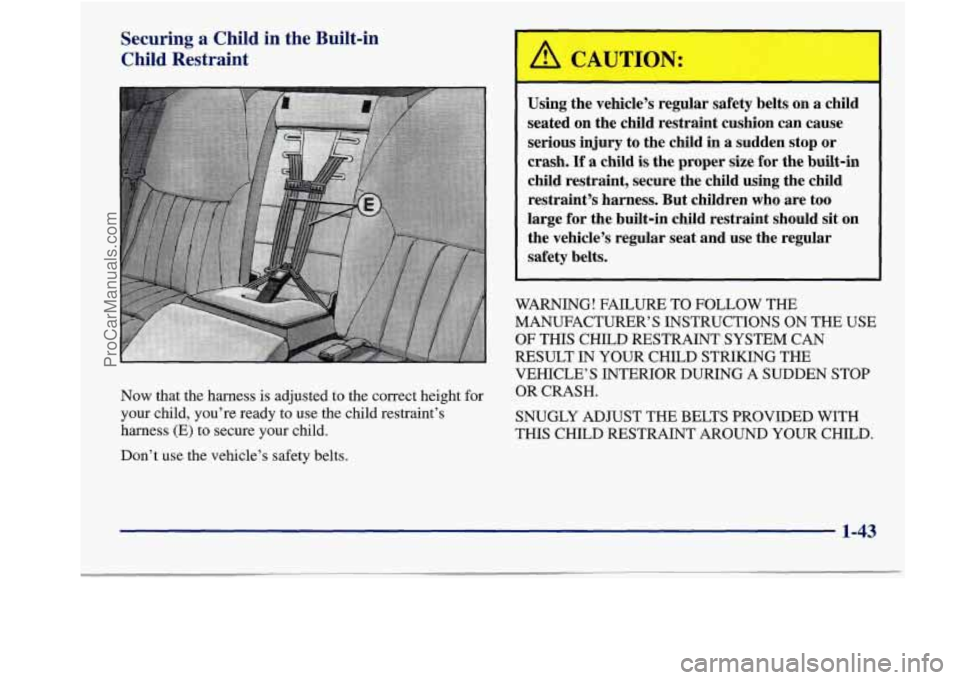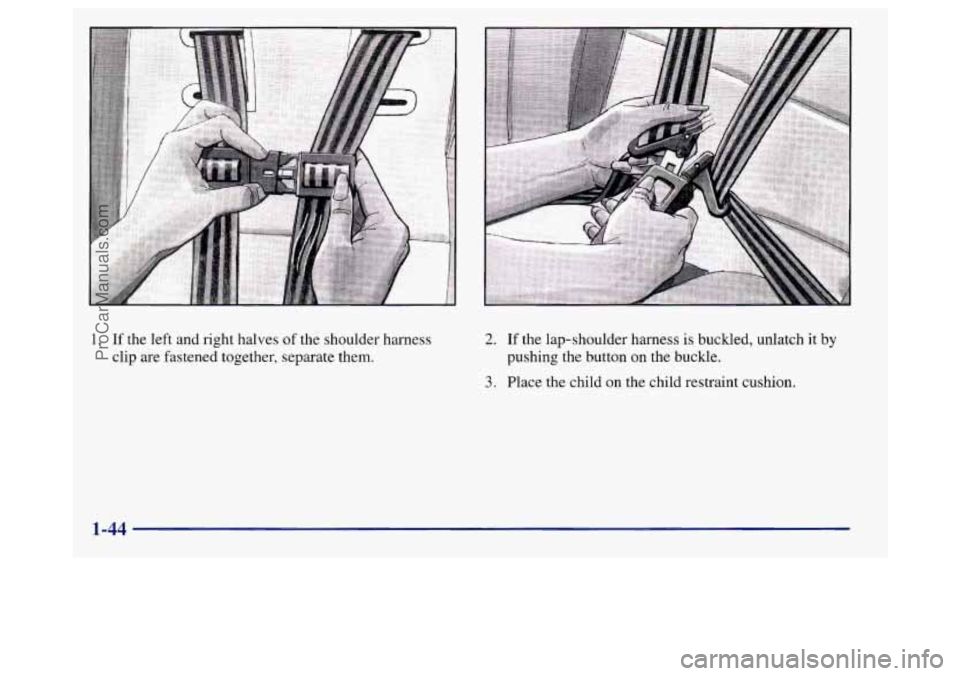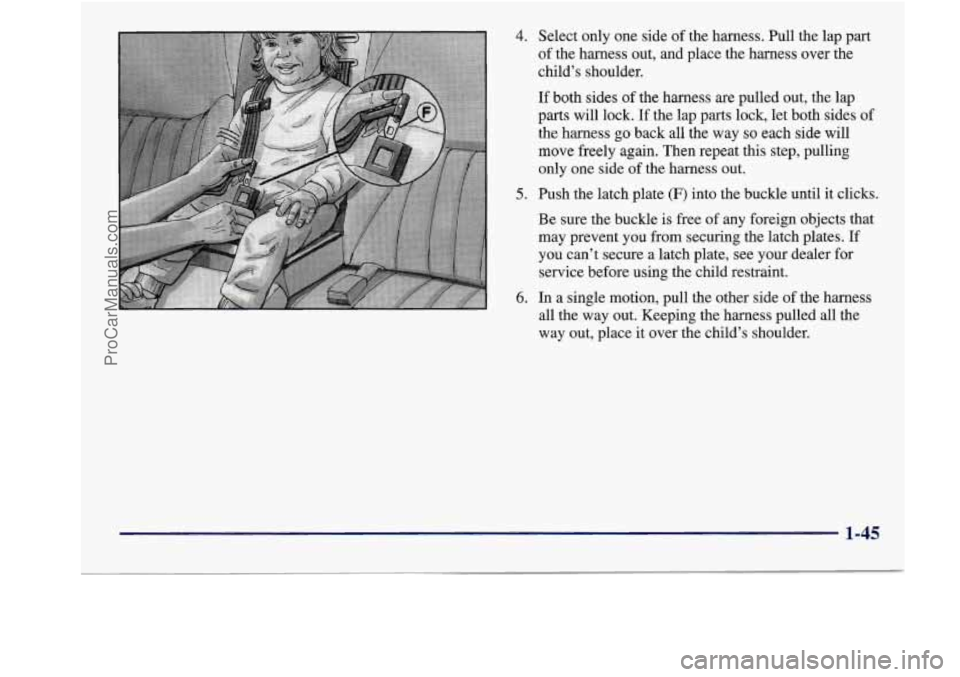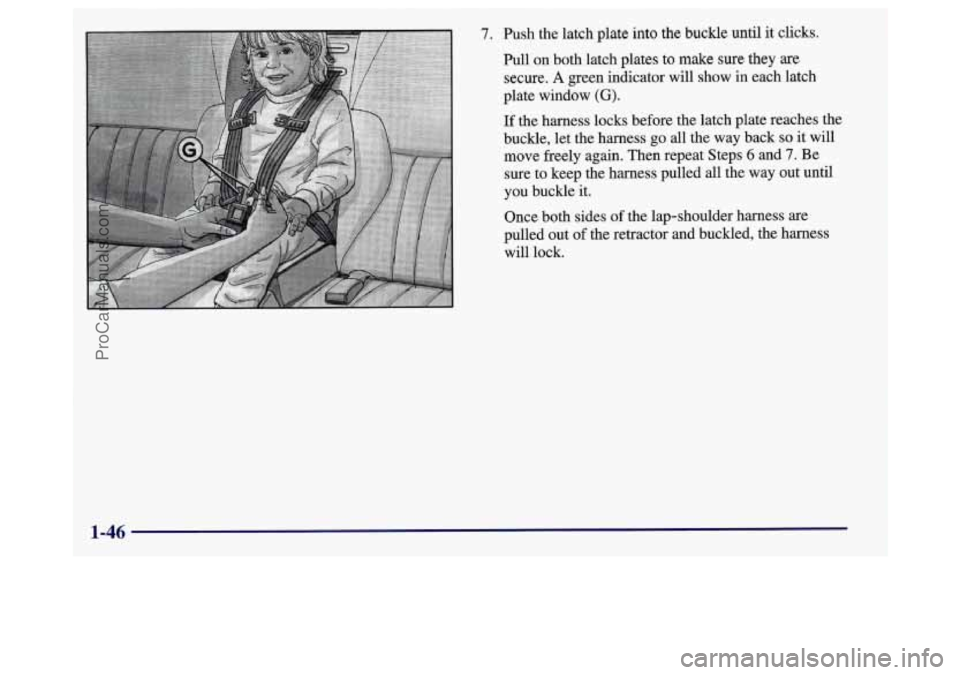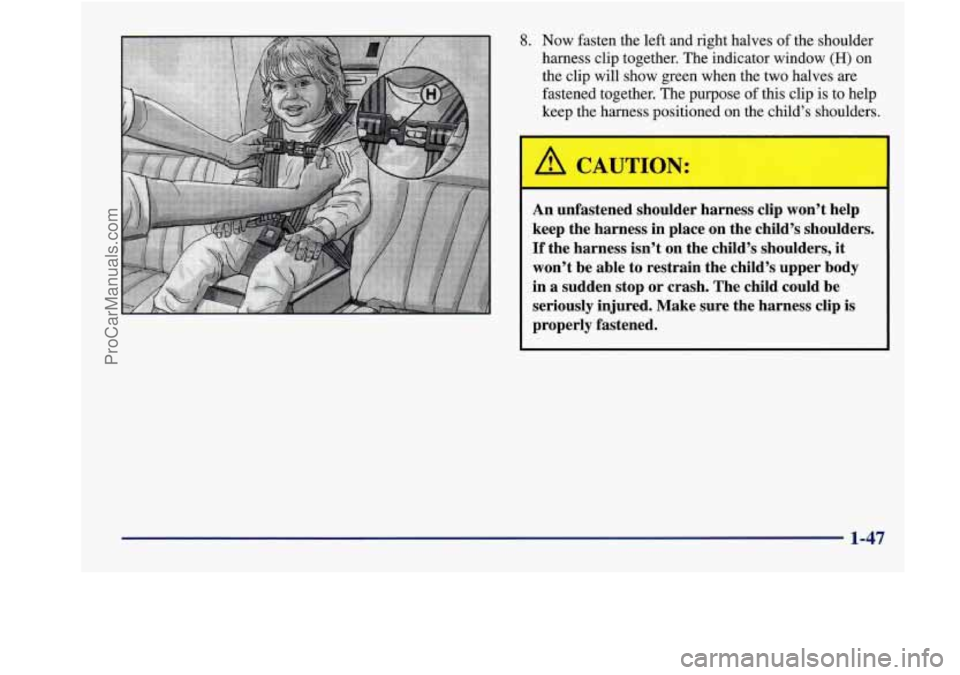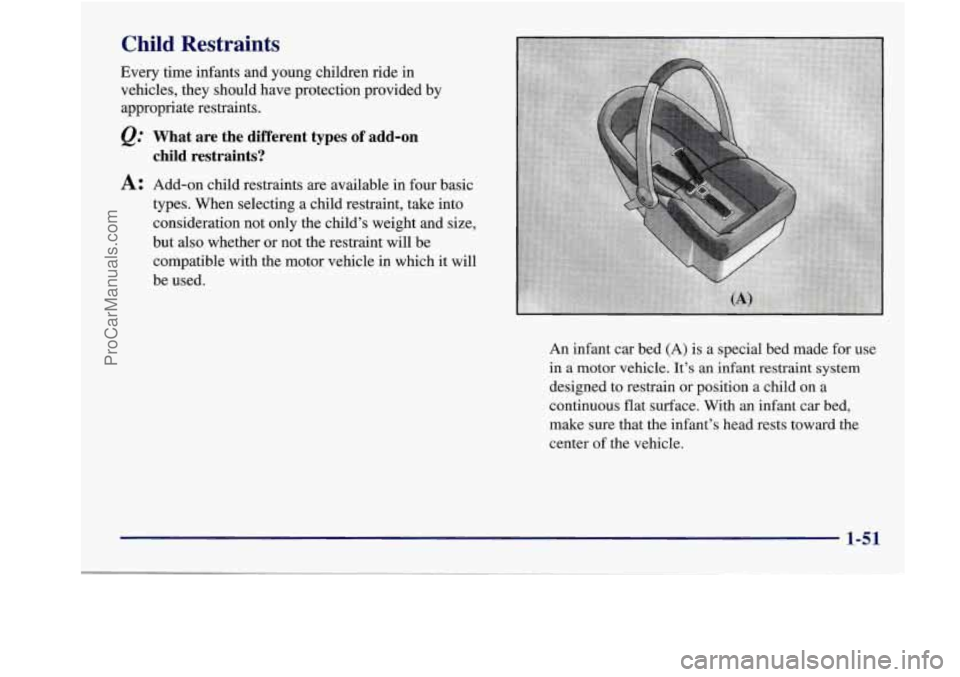BUICK REGAL 1998 Workshop Manual
REGAL 1998
BUICK
BUICK
https://www.carmanualsonline.info/img/43/57697/w960_57697-0.png
BUICK REGAL 1998 Workshop Manual
Trending: headlamp, ABS, door lock, brakes, clock reset, climate control, Running lean
Page 51 of 388
Securing a Child in the Built-in
Child Restraint
Now that the harness is adjusted to the correct height for
your child, you’re ready to use the child restraint’s
harness (E) to secure your child.
Don’t use the vehicle’s safety belts.
Using the vehicle’s regular safety belts on a child
seated on the child restraint cushion can cause
serious injury to the child in a sudden stop or
crash.
If a child is the proper size for the built-in
child restraint, secure the child using the child
restraint’s harness. But children who are too
large for the built-in child restraint should sit on
the vehicle’s regular seat and use the regular
safety belts.
WARNING! FAILURE TO FOLLOW THE
MANUFACTURER’S INSTRUCTIONS
ON THE USE
OF THIS CHILD RESTRAINT SYSTEM CAN
RESULT IN YOUR CHILD STRIKING THE
VEHICLE’S INTERIOR DURING
A SUDDEN STOP
OR CRASH.
SNUGLY ADJUST THE BELTS PROVIDED WITH
THIS CHILD RESTRAINT
AROUND YOUR CHILD.
1-43
ProCarManuals.com
Page 52 of 388
1. If the left and right halves of the shoulder harness
clip are fastened together, separate them. 2. If the lap-shoulder harness is buckled, unlatch it by
pushing the button on the buckle.
3. Place the child on the child restraint cushion.
1-44
ProCarManuals.com
Page 53 of 388
4. Select only one side of the harness. Pull the lap part
of the harness out, and place the harness over the
child’s shoulder.
If both sides of the harness are pulled out, the lap
parts will lock.
If the lap parts lock, let both sides of
the harness go back all the way so each side will
move freely again. Then repeat this step, pulling
only one side of the harness out.
5. Push the latch plate (F) into the buckle until it clicks.
Be sure the buckle is free of any foreign objects that
may prevent you from securing the latch plates.
If
you can’t secure a latch plate, see your dealer for
service before using the child restraint.
6. In a single motion, pull the other side of the harness
all the way out. Keeping the harness pulled all the
way out, place it over the child’s shoulder.
1-45
ProCarManuals.com
Page 54 of 388
7. Push the latch plate into the buckle until it clicks.
Pull on both latch plates to make sure they are
LQC~. A green indkatw will show in each latch
plate
window ((3).
If the harness locks befme the latch plate reaches the
buckle, let the harness go all the way back SO it will
move fjreely again.
Then repeat Steps 6 and 7. Be
sure to keep the lamess pulled all the way out until
you buckle it.
Qnce both sides of the lap-shoulder harness ae
pulled out of the retractor and buckled, the hmess
will lock.
ProCarManuals.com
Page 55 of 388
8. Now fasten the left and right halves of the shoulder
harness clip together. The indicator window
(H) on
the clip will show green when the two halves are
fastened together. The purpose of this clip
is to help
keep the harness positioned
on the child’s shoulders.
A CAUTION:
An unfastened shoulder harness clip won’t help
keep the harness in place on the child’s shoulders.
If the harness isn’t on the child’s shoulders, it
won’t be able to restrain the child’s upper body
in a sudden stop or crash. The child could be
seriously injured. Make sure the harness clip is
properly fastened.
1-47
ProCarManuals.com
Page 56 of 388
If the harness still doesn’t lock, don’t use the child
restraint. See your dealer to have the built-in child
restraint serviced.
9. On both sides of the harness, pull up on the lap part a
little to be sure it’s locked.
If the harness isn’t locked, or if it becomes too tight,
unfasten the harness clip.
Then unlatch the harness
by pushing the button on
the buckle, and let both
sides of the harness go all the way back
so they will
move freely again. Then, repeat Steps
4 through 8.
10. Adjust the position of the harness on the child’s
shoulders by moving the clip
up or down along the
harness. On each side
of the harness, the shoulder
part should be centered on the child’s shoulder. The
harness
should be away from the child’s face and
neck, but not falling off the child’s shoulders.
1-48
ProCarManuals.com
Page 57 of 388
Removing the Child from the Built-in
Child Restraint
2. Unlatch the harness by pushing the button on
the buckle.
1. Unfasten the shoulder harness clip. 3. Move one side of the harness off the child’s
shoulder, and let the harness go all the way back.
4. Move the other side of the harness off the child’s
shoulder, and let it go all the way back.
5. Remove the child from the child restraint cushion.
1-49
ProCarManuals.com
Page 58 of 388
Storing the Built-in Child Restraint
Always properly store the built-in child restraint
before using the vehicle’s lap belt in the center rear
seat position.
1. Buckle the harness and fasten the harness clip.
2. Fold the child restraint cushion and leg rest up into
the seatback.
3. Press the child restraint cushion firmly into the seatback.
4. Then press the leg rest firmly into the seatback, and
secure it by pressing the upper corners against the
fastener strips on the seatback.
Just
like the other restraint systems in your vehicle, your
built-in child restraint needs to be periodically checked
and may need to have parts replaced after
a crash. See
“Checking Your Restraint Systems” and “Replacing Seat
and Restraint System Parts After
a Crash” in the Index.
ProCarManuals.com
Page 59 of 388
Child Restraints
Every time infants and young children ride in
vehicles, they should have protection provided by
appropriate restraints.
What are the different types of add-on
child restraints?
A: Add-on child restraints are available in four basic
types. When selecting a child restraint, take into consideration not only the child’s weight and size,
but
also whether or not the restraint will be
compatible with the motor vehicle in which it will
be used.
An infant car bed
(A) is a special bed made for use
in a motor vehicle. It’s an infant restraint system
designed to restrain or position a child on
a
continuous flat surface. With an infant car bed,
make sure that the infant’s head rests toward the
center of the vehicle.
1-51
ProCarManuals.com
Page 60 of 388
A rear-facing infant restraint (B) positions an infant
to face the rear of the vehicle. Rear-facing infant
restraints
are designed for infants of up to about
20 lbs. (9 kg) and about one year of age. This type
of restraint faces the rear so that the infant’s head,
neck and body can have the support they need in a
crash. Some infant seats come in two
parts -- the
base stays secured in the vehicle and the seat part
is removable.
ProCarManuals.com
Trending: spark plugs, oil viscosity, reset, transmission oil, refrigerant type, service schedule, keyless entry
